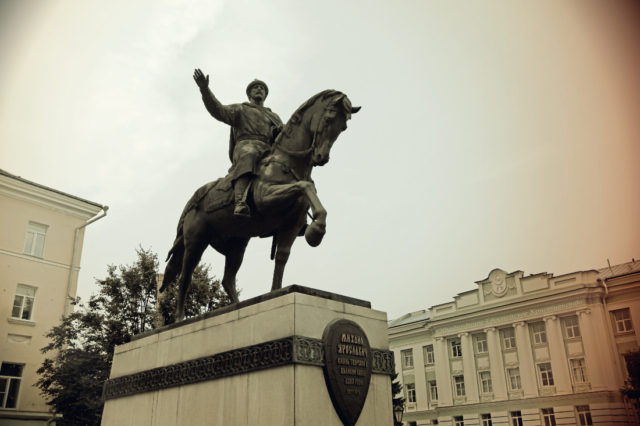
Russian Regions Erecting Statues to Those Who Resisted Muscovite Expansion
Publication: Eurasia Daily Monitor Volume: 14 Issue: 34
By:

Efforts by non-Russian countries to shed Moscow-imposed monuments—from the destruction of Vladimir Lenin statues in the Baltic countries in 1991, to Ukraine’s current effort at de-communizing the public space in that country by taking down memorials to Soviet murderers and renaming streets, cities and towns—have attracted a great deal of attention. But an even more important development in this regard may be taking place within the Russian Federation, where regions and republics are putting up statues and other memorials to historical figures who defended their patrimony against the depredations of the imperial center.
What makes this trend so intriguing is that it is occurring below the radar screen, even as Moscow seeks to promote a common “single-stream” history of the country. Furthermore, it calls into question—more than many commentaries and political statements—the actual level of support for the authoritarian tradition within Russia. Consequently, even though this support for local histories is at least partly predicated on the separate past and separate futures of these places, the appearance of such symbols is undermining Muscovite political culture. Thus potentially, this trend is at least opening the way for a more pluralist and open Russian political system.
In a presentation he made to a St. Petersburg conference last fall on “Terror and Culture,” Russian political commentator Daniil Kotsyubinsky points to “memorials to ‘local cultural heroes,’ which in recent years have been established and continue to be erected in Russian regions and not just in national republics.” He adds that many of these heroes won their fame and support by the resistance they showed to “the expansion of the Muscovite state, which was based on total state terror” (Daniil Kotsyubinsky, Fear and Memory: Sovereign Terror as the Basis of Russian Political Culture,” Terror and Culture: A Collection of Essays, in Russian; St. Petersburg: SPBGU, 2016, available at Afterempire.info, March 14).
Among the statues and memorials he mentions are one to Prince Mikhail Yaroslavich in Tver, Marfa Posadnitsa in Novgorod Veliky, Oleg Ryazansky in Ryazan, and to the victims of Ivan the Terrible’s conquest of Kazan in 1552 (Afterempire.info, March 14). His list could easily be extended to include memorials to leaders in the North Caucasus who resisted the Russian advance there in the 18th and 19th centuries (see EDM, September 26, 2013; July 15, 2014) and in Siberia, where the local populations have an even longer history of resisting Moscow’s imperial project.
Until recently, Kotsyubinsky says, almost all the statuary in Russia reflected “the system-forming and ‘pattern-forming’ specifics of the establishment of Russian political culture” dating back to time of the Mongol conquest. At that time, he argues, Muscovy did not so much resist as integrate itself as a colonial outpost of the Mongol state. Within that relationship, slavish obedience to the powers that be became the principle for relations at all levels of the country. Or as Russian historian Nikolay Karamzin put it, “political slavery was the foundation of the Russian-Muscovite national-state establishment” (Afterempire.info, March 14).
To further support his argument that Muscovy accepted rather than resisted Mongol arrangements, Kotsyubinsky cites the research of United States historian Richard Pipes, who has concluded that between 1252 and 1448, Muscovy did not fight what it later called “the Mongol yoke” but rather cooperated fully with its masters and expected those it established rule over to do the same, even though, as the historical record shows, not all leaders or peoples in Eurasia adopted the same approach. Many resisted far more than Muscovy did, and some of these heroes are now being recalled in the new monuments.
But Muscovy set the tone and ensured that “the main quality of the Russian national spirit, and at the same time the chief instrument of the integration of the Russian state […] remained in unchanged fashion the subordinates’ fear of state terror…” And out of this fear, Kotsyubinsky asserts, Russian society essentially developed “Stockholm syndrome,” whereby those taken over by force come to identify with and even share the values of those who have seized them.
Not surprisingly, Kotsyubinsky continues, “the main cultural heroes of ‘the slavish half’ of Russian political memory are the rulers.” They have typically been accorded the monuments and the glory. The main heroes of the other part of Russian culture, those who led risings against the rulers, have tended to be celebrated only if they displace the previous rulers and come to power, as happened with the Bolsheviks in 1917. Now, however, “the two sides of one and the same ‘power-terrorist medal’ ” are on public view, with the defenders of the latter increasingly getting their way. But it is still the case, he observes, that “to this day the possibility of establishing a liberal-democratic culture and a historical memory adequate to support it have been blocked [by Moscow].”
What that has meant in the past, he says, is that any dramatic liberalization soon leads to a recrudescence of the older slavish mentality; but Kotsyubinsky expresses hope that with the new monumental architecture that is coming to the fore, “at a certain moment, Russian political culture and the jail-like state that rests on it will come to an end.” The new monuments thus give hope to Russian democratic-liberals and federalists—although no guarantees.



